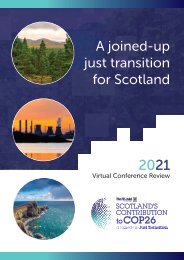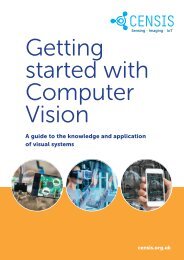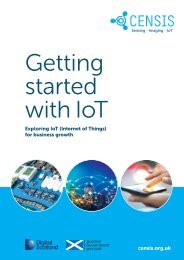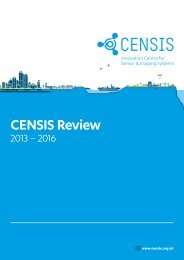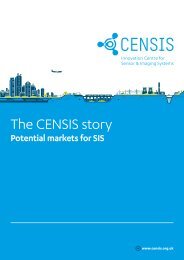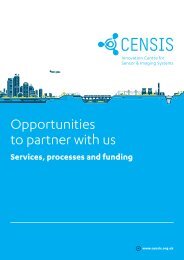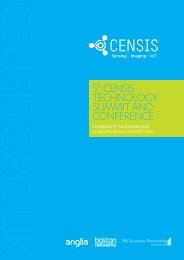CENSIS white paper: Intellectual Property in Business
2023: This CENSIS white paper sets out to make the topic of IP more approachable, less intimidating and more manageable, offering experience-based advice and methods are are designed to help businesses structure their IP- related issues and makes the best of their IP. Covering: The role of IP, IP management during growth, IP strategy for expanding companies and corporates, Business IP Canvas - merging IP with your business model.
2023: This CENSIS white paper sets out to make the topic of IP more approachable, less intimidating and more manageable, offering experience-based advice and methods are are designed to help businesses structure their IP- related issues and makes the best of their IP.
Covering:
The role of IP, IP management during growth, IP strategy for expanding companies and corporates, Business IP Canvas - merging IP with your business model.
You also want an ePaper? Increase the reach of your titles
YUMPU automatically turns print PDFs into web optimized ePapers that Google loves.
<strong>Intellectual</strong> <strong>Property</strong> <strong>in</strong> Bus<strong>in</strong>ess: IP basics, IP management, IP strategy<br />
Appendix 1<br />
Bus<strong>in</strong>ess IP Canvas<br />
Bus<strong>in</strong>ess IP Canvas<br />
Key Partners<br />
Appendix 1<br />
Key Activities Key Resources Value Propositions Customer Relationships Channels Market Segments<br />
Who are our key partners? Who<br />
are our key suppliers? Which<br />
key resources are we acquir<strong>in</strong>g<br />
from partners? Which key<br />
activities do partners perform?<br />
What is relevant from the po<strong>in</strong>t of IP:<br />
# Do you outsource manufactur<strong>in</strong>g of<br />
certa<strong>in</strong> components to third parties?<br />
If so, do you have an agreement <strong>in</strong><br />
place that specifies what IP rights are<br />
<strong>in</strong>volved <strong>in</strong> the ‘knowledge’ transfer?<br />
(E.g., patents, know-how,<br />
manufactur<strong>in</strong>g designs, any copyright<br />
protected materials.)<br />
# Do you acquire third-party IP that<br />
you implement <strong>in</strong> your product/<br />
service? E.g., software modules,<br />
certa<strong>in</strong> hardware sub-components.<br />
# Is there any shared IP (through<br />
collaborative R&D projects) that is part<br />
of your solution?<br />
# Is there any other entity that can<br />
commercialise to the same IP as you?<br />
If so, do you consider them your<br />
competitors? Can they become your<br />
competitors <strong>in</strong> the future, as you<br />
expand <strong>in</strong>to other markets?<br />
# Do you have NDAs <strong>in</strong> place?<br />
Be aware of confidential <strong>in</strong>formation<br />
you are disclos<strong>in</strong>g (your <strong>in</strong>formation)<br />
and receiv<strong>in</strong>g (your partner’s<br />
<strong>in</strong>formation).<br />
# Do you have a confidentiality/trade<br />
secret policy <strong>in</strong> place?<br />
You need to record this <strong>in</strong>formation to<br />
(1) track the (co-)users of your IP and<br />
(2) have clarity about third-party IP<br />
implemented <strong>in</strong> your solution.<br />
Royalties/licens<strong>in</strong>g fees that you<br />
pay represent costs that you should<br />
consider to <strong>in</strong>clude <strong>in</strong> your pric<strong>in</strong>g<br />
policy.<br />
What key activities do our<br />
value propositions require? Our<br />
distribution channels? Customer<br />
eelationships? Revenue<br />
streams?<br />
# Do you need to strengthen the IP<br />
protection of your solution?<br />
# Are you consider<strong>in</strong>g creat<strong>in</strong>g a<br />
diverse IP portfolio, <strong>in</strong>clud<strong>in</strong>g e.g.,<br />
design protection, copyrighted<br />
materials, patents, trade secrets?<br />
# Do you plan to apply for (more)<br />
patents?<br />
# Did you do a trade mark analysis of<br />
your company/product name?<br />
# Consider FTO-analysis before the<br />
product launch. Consult an IP lawyer/<br />
specialist about this matter.<br />
# Do you need to acquire an IP<br />
licence to m<strong>in</strong>imalise the risk of IP<br />
right <strong>in</strong>fr<strong>in</strong>gement?<br />
# Any chances of cross-licens<strong>in</strong>g of<br />
your IP rights with your competitors<br />
or other parties?<br />
# Any chances of jo<strong>in</strong><strong>in</strong>g a patent<br />
pool as a licens<strong>in</strong>g option?<br />
# If your R&D works have been<br />
f<strong>in</strong>anced <strong>in</strong> a publicly funded project,<br />
review the contractual obligations<br />
with regard to the ownership and use<br />
of IP (foreground and background).<br />
Under this category, you should<br />
enlist all identified IP that relates<br />
to your solution (owned by your<br />
company and/or from third<br />
parties).<br />
If you are already record<strong>in</strong>g your IP<br />
rights <strong>in</strong> a more formalised way – e.g.,<br />
<strong>in</strong> an IP register – only <strong>in</strong>dicate this<br />
here.<br />
In an IP register, you should catalogue<br />
all IP rights: (un)registred and nonregistrable.<br />
E.g., patent applications,<br />
granted patents, abandoned patents,<br />
trade secrets, copyrights (source code<br />
modules), designs, trademarks.<br />
Include NDAs and R&D contracts<br />
(from ‘Key partners’) to complete the<br />
IP picture of your company.<br />
What value do we deliver to the<br />
customer? Which one of our<br />
customer’s problems are we<br />
help<strong>in</strong>g to solve? What bundles<br />
of products and services are<br />
we offer<strong>in</strong>g to each customer<br />
segment? Which customer<br />
needs are we satisfy<strong>in</strong>g?<br />
Def<strong>in</strong><strong>in</strong>g your value proposition (VP)<br />
is the focal po<strong>in</strong>t of the bus<strong>in</strong>ess<br />
model canvas. VP is equally important<br />
when it comes to identify<strong>in</strong>g and<br />
understand<strong>in</strong>g your IP-related<br />
potential.<br />
A separate table should guide you<br />
<strong>in</strong> def<strong>in</strong><strong>in</strong>g your IP assets based on<br />
your VP.<br />
Here are just a few explanatory<br />
comments:<br />
Try to rank your VP characteristics.<br />
This will support you <strong>in</strong> tak<strong>in</strong>g<br />
decisions with regard to the shape<br />
of your IP portfolio. This way you<br />
ga<strong>in</strong> valuable <strong>in</strong>formation on the<br />
importance of each IP right that<br />
relates to a specific feature of your VP.<br />
The difference between this section<br />
and ‘Key resources’ is that here you<br />
(1) attempt to match IP rights with<br />
What type of relationship does<br />
each of our customer segments<br />
expect us to establish and<br />
ma<strong>in</strong>ta<strong>in</strong> with them? Which<br />
ones have we established? How<br />
are they <strong>in</strong>tegrated with the rest<br />
of our bus<strong>in</strong>ess model? How<br />
costly are they?<br />
# Do you <strong>in</strong>tend to <strong>in</strong>volve your<br />
customers (B2C) <strong>in</strong> design<strong>in</strong>g new<br />
products/services? As <strong>in</strong> ‘co-creation’.<br />
Please def<strong>in</strong>e terms for the ownership<br />
and use/exploitation of ‘co-created’<br />
ideas. This usually happens <strong>in</strong> a<br />
manner of a licence (exclusive, nonexclusive).<br />
Open source and/or Creative<br />
Commons licenses can be useful<br />
here.<br />
Please also consider whether to<br />
<strong>in</strong>clude compensation of co-creators.<br />
# Do you <strong>in</strong>tend to collaborate with<br />
your customers (B2B) on jo<strong>in</strong>t further<br />
developments of your technology?<br />
It is important to contractually specify<br />
the ownership and exploitation rights<br />
of the foreground IP (i.e., IP generated<br />
dur<strong>in</strong>g the project).<br />
Through which channels do<br />
our customer segments want<br />
to be reached? How are we<br />
reach<strong>in</strong>g them now? How are<br />
our channels <strong>in</strong>tegrated? Which<br />
ones work best? Which ones are<br />
most cost-efficient? How are we<br />
<strong>in</strong>tegrat<strong>in</strong>g them with customer<br />
rout<strong>in</strong>es?<br />
What is relevant from the po<strong>in</strong>t of IP:<br />
# Indirect distribution / White label?<br />
Does the agreement <strong>in</strong>cludes IP<br />
clauses? Which IP rigts (e.g., patents,<br />
secret know-how, designs) are<br />
<strong>in</strong>volved and which explotiation rights<br />
are granted?<br />
# Direct onl<strong>in</strong>e distribution<br />
(e-commerce)<br />
For whom are we creat<strong>in</strong>g<br />
value? Who are our most<br />
important customers? Is our<br />
customer base a mass market,<br />
niche market, segmented,<br />
diversified, multi-sided platform?<br />
In the ‘Bus<strong>in</strong>ess IP canvas’, this box<br />
changes its profile, and focuses on the<br />
target market and your competitors –<br />
from the IP perspective.<br />
The follow<strong>in</strong>g questions should help<br />
you to gather specific <strong>in</strong>formation:<br />
# Do you know your competitors’ IP<br />
practices?<br />
Do they apply for patent protection?<br />
Do you monitor such activities?<br />
Consult your patent attorney on this.<br />
Do your competitors release their<br />
source code (as open source)?<br />
How does their IP practice reflect their<br />
bus<strong>in</strong>ess model?<br />
# Who is the strongest ‘<strong>in</strong>ventor’ <strong>in</strong> the<br />
specific market?<br />
# Are IP rights respected <strong>in</strong> your target<br />
market?<br />
# How does the supply cha<strong>in</strong> <strong>in</strong> the<br />
target market look like?<br />
In which countries are products/<br />
components be<strong>in</strong>g produced, and to<br />
which are they distributed, and sold?<br />
# Where does your company fit <strong>in</strong> the<br />
supply cha<strong>in</strong> structure of the target<br />
market?<br />
# In case of IP licens<strong>in</strong>g, how will your<br />
potential licensee use your IP?<br />
Will they use it to produce goods?<br />
Do they acquire IP to block other<br />
competitors?<br />
The better you know the target<br />
market, the clearer perspective you<br />
will have when it comes to IP strategy.<br />
When it comes to learn<strong>in</strong>g about the<br />
IP practices of your competitors, it’s<br />
not so much about do<strong>in</strong>g the same<br />
th<strong>in</strong>g, as about understand<strong>in</strong>g how<br />
they play their game and how their IP-<br />
Cost Structure<br />
Revenue Streams<br />
What are the most important costs <strong>in</strong>herent <strong>in</strong> our bus<strong>in</strong>ess model? Which key resources are most expensive? Which<br />
key activities are most expensive?<br />
IS YOUR BUSINESS MORE: Cost-driven (leanest cost structure, low price value proposition, maximum automation,<br />
extensive outsourc<strong>in</strong>g), or value-driven (focused on value creation, premium value proposition).<br />
SAMPLE CHARACTERISTICS: Fixed costs (salaries, rents, utilities), variable costs, economies of scale, economies of<br />
scope.<br />
# How much can you spend on IP registration/applications? Do you have budget restra<strong>in</strong>rs?<br />
# What are the cots <strong>in</strong>curred up until now?<br />
Please <strong>in</strong>clude costs of IP applications (patent attorney fees, office fees), royalties for photos, graphics, videos, etc.<br />
For what value are our customers really will<strong>in</strong>g to pay? For what do they currently pay? How are they currently pay<strong>in</strong>g?<br />
How would they prefer to pay? How much does each revenue stream contribute to overall revenues?<br />
TYPES: Asset sale, usage fee, subscription fees, lend<strong>in</strong>g/rent<strong>in</strong>g/leas<strong>in</strong>g, licens<strong>in</strong>g, brokerage fees, advertis<strong>in</strong>g<br />
FIXED PRICING: List price, product feature dependent, customer segment dependent, volume dependent<br />
DYNAMIC PRICING: Negotiation (barga<strong>in</strong><strong>in</strong>g), yield management, eeal-time-market<br />
# What are the prospects of generat<strong>in</strong>g revenues through the licens<strong>in</strong>g of your technology?<br />
Licens<strong>in</strong>g your technology (i.e., IP rights) can be your bus<strong>in</strong>ess model (one of them, depend<strong>in</strong>g on the market).<br />
# How much value can you capture from it?<br />
# Which IP rights could you license?<br />
Designed by: The Bus<strong>in</strong>ess Model Foundry (www.bus<strong>in</strong>essmodelgeneration.com/canvas). Word implementation by: Neos Chronos Limited (https://neoschronos.com). License: CC BY-SA 3.0<br />
Modified by: Natalia Lukaszewicz, University of Glasgow, last modification 10 January 2022<br />
52<br />
Download an A3 version of the Bus<strong>in</strong>ess IP canvas at: https://censis.org.uk/bus<strong>in</strong>ess-ip-canvas-download/<br />
The Bus<strong>in</strong>ess IP Canvas is based on the Bus<strong>in</strong>ess Model Canvas designed by Strategyzer AG<br />
https://www.strategyzer.com/canvas/bus<strong>in</strong>ess-model-canvas, licensed under the Creative Commons<br />
Attribution-Share Alike 3.0 Unported License<br />
Modified by Natalia Lukaszewicz, last modification 10 January 2023, “Bus<strong>in</strong>ess IP Canvas”<br />
licensed under Creative Commons Attribution-Share Alike 3.0 Unported License<br />
52






